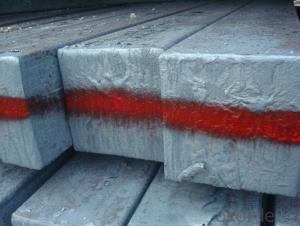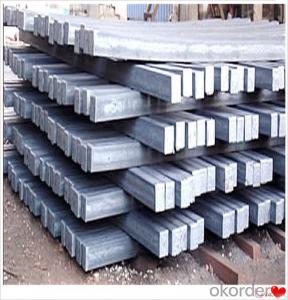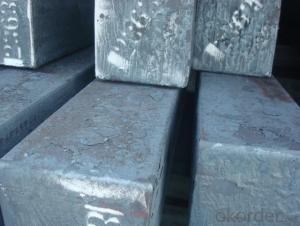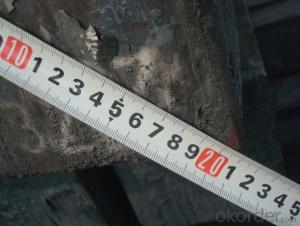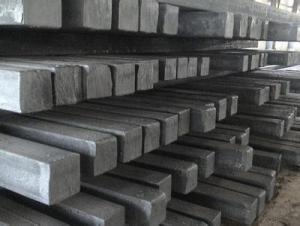Steel Billet Hot Rolled Q235/275 in Amazing Price
- Loading Port:
- Tianjin
- Payment Terms:
- TT OR LC
- Min Order Qty:
- 1000 m.t.
- Supply Capability:
- 50000 m.t./month
OKorder Service Pledge
OKorder Financial Service
You Might Also Like
1.Structure of Steel Billet
Steel billet(ingot) by cogging or breakdown of semi-finished products, is the raw material of all kinds of steel mill. Billet section of square, round, flat, rectangular and abnormity of several kinds of, mainly related to the shape of rolled products.
2.Main Features of Steel Billet
Rectangular billet continuous casting billet and mainly general carbon steel, low carbon low silicon cold-rolled material, high quality carbon structural steel, high strength low alloy steel, special steel, etc.
The billet is mainly divided into two kinds from the shape:
Slab: cross section width and height of the ratio of the larger, mainly used for rolling plate.
Billet: equal cross section width and height, or a huge difference, mainly used for rolling steel, wire rod. ,
Steel billets have distinct characteristics as compared with already furnished steel bars and products. Billets have a specific grain structure, which enables the metal to be processed more intricately. Steel billets are also known for their malleability and ductility, especially when exposed to varying temperatures during shaping and molding.
3.Steel Billet Images


4.Usage of Steel Billet
Billets, or ingots (as they sometimes referred to), are not of practical use until they have been formed into more functional shapes and sizes. While they have already been put in the furnace, they still require a series of shaping and molding procedures such as hot and cold working, milling and cutting before they are sold in hardware stores, or used for different applications. The unformed billets, however, can be used in striking currency such as coins and as reserves, similar to gold bars.
5. Steel Billet Specification
Hot rolled billet steel
Size: 50x50mm-180x180mm
Steel Grade: 3SP, 5SP,Q195,Q235,Q255,Q275 Length:3m-12m
MOQ: 1000MT/size
Payment term: TT or LC
Packing: in bulk , bundle
Shipment: by container , bulk vessel
Packaging Details: bundles with steel strips or as customers's requirements
Delivery time: 15-30 days after the deposit
Loading port:Tianjin, or other port China
Origin :China
Inspection:Third party inspection before loading.
6.FAQ
We have organized several common questions for our clients,may help you sincerely:
1) How to guarantee the quality of the products?
We have established the international advanced quality management system,every link from raw material to final product we have strict quality test;We resolutely put an end to unqualified products flowing into the market. At the same time, we will provide necessary follow-up service assurance.
2)Do you have your own QC department?
Yes, we have, our QC department will inspect the goods during the process of mass production and after completion of production.
3)Do you have your own QC department?
Yes, we have, our QC department will inspect the goods during the process of mass production and after completion of production.
- Q: What are the main steel billet producing countries?
- The main steel billet producing countries are China, India, Russia, Japan, and the United States. China is the largest producer of steel billets, accounting for approximately half of the global production. This is followed by India, which has also emerged as a major player in the steel industry. Russia, known for its vast reserves of iron ore and coal, is another significant producer of steel billets. Japan, a highly industrialized nation, has a well-established steel industry and contributes significantly to the global production. Lastly, the United States, with its advanced technology and large steel mills, also plays a significant role in steel billet production. These countries not only produce steel billets for domestic consumption but also export to meet the global demand for steel products.
- Q: What are the different shapes and forms of steel billets?
- Depending on their intended use and manufacturing process, steel billets are available in a variety of shapes and forms. Casting is the typical process used to achieve the most common shapes, which include square, rectangular, round, and hexagonal. Square billets are widely used and are often rolled into long products such as bars, rods, and wire. Rectangular billets, with longer sides compared to their width, are also rolled into long products but are typically used for applications that require a larger cross-sectional area. Round billets, as their name suggests, are cylindrical and primarily used for producing seamless tubes, pipes, and other tubular products. The round shape is preferred in these applications as it allows for a more uniform distribution of stresses during manufacturing. Hexagonal billets, with their six sides, are commonly used for forging and machining. Their unique shape provides greater strength and stability, making them suitable for producing high-quality components like bolts, nuts, and other fasteners. In addition to these common shapes, steel billets can also be customized to meet specific requirements in terms of shape and size. Specialized molds or further processing techniques like extrusion or hot rolling can be used to achieve these custom shapes. Overall, the various shapes and forms of steel billets enable the production of a wide range of steel products, each tailored to its specific application and manufacturing process.
- Q: How long do steel billets last?
- Steel billets can last for a very long time, depending on various factors such as their storage conditions and usage. Generally, if steel billets are stored properly in a controlled environment with low humidity and protected from corrosion, they can last indefinitely. However, if they are exposed to harsh weather conditions, excessive moisture, or corrosive substances, their lifespan can be significantly reduced. In terms of usage, steel billets are typically melted down and used to produce other steel products, such as bars, rods, and beams. The lifespan of the final product will depend on its specific application and the maintenance practices employed. Generally, steel products are known for their durability and longevity, making them a reliable choice in various industries.
- Q: What are the main factors affecting the fatigue strength of steel billets?
- The fatigue strength of steel billets can be influenced by several key factors. 1. Material Composition: The fatigue strength of a steel billet depends on its composition, including the type and quantity of alloying elements present. Elements like carbon, manganese, and silicon have an impact on the billet's ability to resist fatigue and endure cyclic loading. 2. Surface Quality: The fatigue strength of steel billets is closely tied to their surface quality. Surface defects, such as cracks, scratches, or pits, can act as stress concentrators, leading to premature fatigue failure. Therefore, it is imperative to properly prepare and inspect the surface to ensure high fatigue resistance. 3. Heat Treatment: The fatigue strength of a steel billet can be significantly influenced by the heat treatment process used to modify its microstructure. Employing appropriate heat treatment techniques, like quenching and tempering, can enhance the billet's fatigue resistance by improving its hardness, strength, and toughness. 4. Grain Size: The fatigue strength of a steel billet is also affected by the grain size of its microstructure. Finer grains generally exhibit greater fatigue resistance due to reduced stress concentration and enhanced grain boundary strength. 5. Residual Stress: Residual stresses, which can arise from various manufacturing processes, play a crucial role in determining the fatigue strength of steel billets. Excessive residual stress can serve as a starting point for fatigue cracks, thereby diminishing the billet's fatigue life. 6. Operating Conditions: The fatigue strength of steel billets can be influenced by the conditions under which they operate. Factors such as the magnitude and frequency of applied cyclic loads, as well as the temperature, can all have a detrimental impact on the billet's fatigue life. 7. Environmental Factors: The environment in which a steel billet operates can also affect its fatigue strength. Variables like humidity, corrosive gases, and exposure to chemicals can accelerate the initiation and propagation of fatigue cracks, resulting in reduced fatigue resistance. Taking into account and comprehending these primary factors that impact the fatigue strength of steel billets is crucial when designing components and structures that can endure cyclic loading and ensure long-term reliability.
- Q: 100Q235 steel can only be rolled from billets of Q235?Or a billet can be rolled into Q195~Q215 and other models of steel?Is there a detailed classification of billets? Do you have GB?
- Billet classification of GB, it is convenient to check
- Q: What are the different surface treatments for improved fatigue resistance in steel billets?
- Some of the different surface treatments that can improve fatigue resistance in steel billets include shot peening, nitriding, and induction hardening. Shot peening involves bombarding the surface of the billets with small steel shots, which creates compressive stresses that help to increase fatigue strength. Nitriding is a process where the steel billets are exposed to nitrogen gas at high temperatures, forming a hard nitride layer on the surface which improves both hardness and fatigue resistance. Induction hardening involves heating the surface of the billets using high-frequency currents and then rapidly quenching it, resulting in a hardened surface layer that enhances fatigue resistance.
- Q: How are steel billets used in the manufacturing of automotive parts?
- Steel billets are used in the manufacturing of automotive parts by being heated and shaped into various forms such as rods, bars, and sheets. These billets serve as the raw material for forging, casting, and machining processes, enabling the production of critical components like engine blocks, crankshafts, suspension systems, and chassis. The high strength and durability of steel make it an ideal choice for automotive applications, ensuring the safety and performance of vehicles.
- Q: How do steel billets contribute to the chemical industry?
- Steel billets are an essential raw material in the chemical industry for the production of various chemicals and chemical products. These billets, which are solid bars or rods of steel, play a crucial role in the manufacturing process. Firstly, steel billets are used in the construction of reactors and vessels that are used in chemical production plants. These reactors are designed to withstand high temperatures and pressure, and steel billets provide the necessary strength and durability for these applications. The chemical reactions that take place in these reactors often involve corrosive or harsh chemicals, and the use of steel billets ensures that the equipment remains intact and prevents any leaks or accidents. Furthermore, steel billets are also used in the production of catalysts, which are substances that facilitate chemical reactions without being consumed in the process. Many catalysts are made from metals or metal oxides, and steel billets are often used as the base material for their production. By providing a stable and strong foundation, steel billets help ensure the efficiency and effectiveness of these catalysts. Additionally, steel billets are used in the construction of pipelines and storage tanks that are crucial for transporting and storing chemicals. These structures need to be able to withstand high pressures and corrosive environments, and steel billets are the preferred material due to their strength, durability, and resistance to chemical degradation. They ensure the safe and efficient transportation and storage of chemicals, which is crucial for the chemical industry. In conclusion, steel billets are indispensable in the chemical industry due to their strength, durability, and resistance to chemical degradation. They are used in the construction of reactors, vessels, catalysts, pipelines, and storage tanks, all of which are essential components of chemical production and transportation. Without steel billets, the chemical industry would struggle to operate efficiently and safely.
- Q: What are the common heat treatment processes for steel billets?
- Steel billets can undergo several heat treatment processes to modify their mechanical properties, including hardness, strength, and toughness, to meet specific requirements for different applications. One prevalent heat treatment process for steel billets is annealing. This involves heating the steel to a specific temperature and maintaining it at that temperature for a set duration, followed by gradual cooling. Annealing helps alleviate internal stresses in the steel, improve its machinability, and enhance its ductility. Another widely used heat treatment process for steel billets is quenching and tempering. Quenching involves rapidly cooling the steel from a high temperature to room temperature using a liquid or gas medium, like water or oil. This process results in hardened steel with increased strength and hardness. However, the steel becomes brittle after quenching, so it is then tempered by reheating it to a lower temperature and holding it at that temperature for a specific time period. Tempering reduces brittleness and improves the toughness and ductility of the steel. Normalizing is another heat treatment process employed for steel billets. It entails heating the steel to a temperature above its critical transformation temperature and then cooling it in still air. Normalizing helps refine the grain structure of the steel, improve its mechanical properties, and enhance its machinability. Lastly, stress relieving is a process used to reduce internal stresses in steel billets that may have been generated during manufacturing processes such as casting or forging. Stress relieving involves heating the steel to a specific temperature and maintaining it at that temperature for a certain duration, followed by gradual cooling. This process aids in improving dimensional stability and reducing the risk of distortion or cracking in the steel. Overall, these common heat treatment processes for steel billets play a vital role in optimizing the properties and performance of steel for various industrial applications, including automotive, construction, aerospace, and energy sectors.
- Q: What is billet?
- Mould blank and continuous casting billet: mould blank and continuous casting billet,
Send your message to us
Steel Billet Hot Rolled Q235/275 in Amazing Price
- Loading Port:
- Tianjin
- Payment Terms:
- TT OR LC
- Min Order Qty:
- 1000 m.t.
- Supply Capability:
- 50000 m.t./month
OKorder Service Pledge
OKorder Financial Service
Similar products
Hot products
Hot Searches
Related keywords










